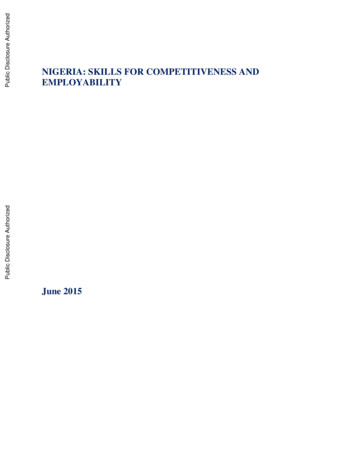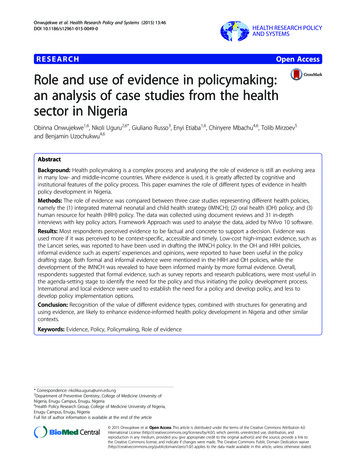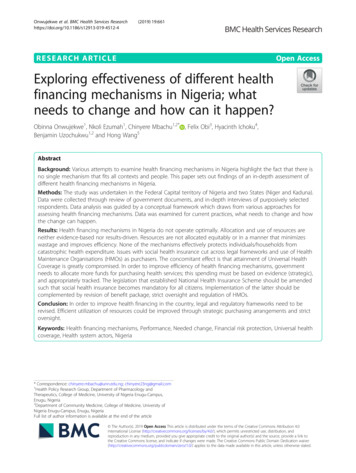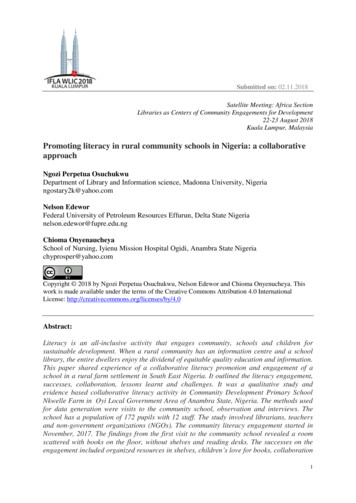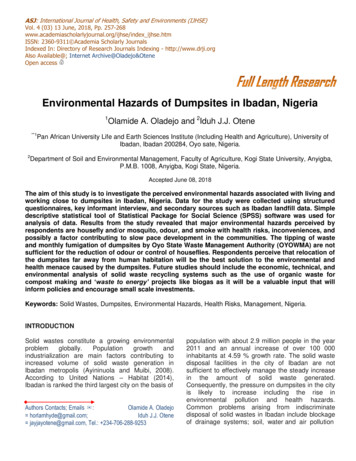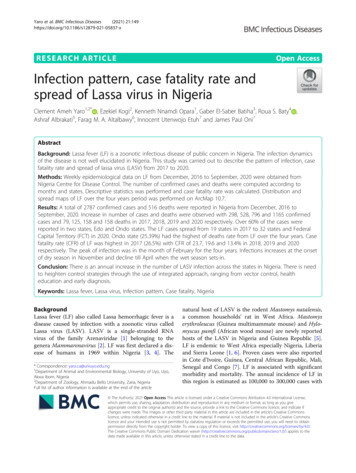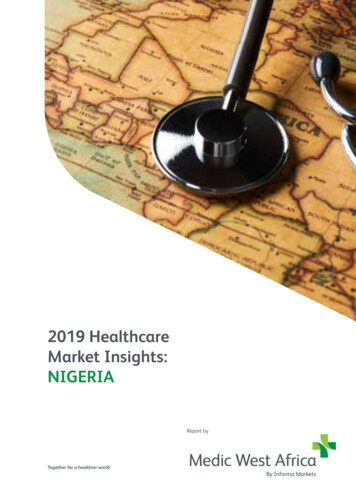
Transcription
2019 HealthcareMarket Insights:NIGERIAReport byTogether for a healthier world
ContentsMarket synopsis3Health expenditure4Health policy & provision5Health insurance & social protection 6Private sector participation710 investment opportunities8The workforce9Medical tourism10How to restore patient’s trust11medicwestafrica.com
Market SynopsisAccording to statistics from the Nigerian EconomicRecovery & Growth Plan 2017-2020, at 52 years,the average life expectancy in Nigeria is lower thanthat of its peer African countries, e.g., Ghana (61years) and South Africa (57 years). The prevalenceof infectious diseases remains high. Nigeria rankspoorly on the incidence of tuberculosis (128 outof 138 countries) and the prevalence of HIV (123out of 138 countries). On under-five child mortality,there are 89 deaths per 1,000 live births, a levelfar above the target of 64 deaths per 1,000 livebirths set in the UN Sustainable Development Goals(SDGs).However, some progress has been made over thelast 20 years. The maternal mortality rate in 2014was 576 deaths per 100,000 live births comparedto 1,000 deaths per 100,000 live births in 1990.However, Nigeria has a long way to go to meet theUN SDG of 70 deaths per 100,000 live births by2030.Analysis by the Oxford Business Group (OBG)suggests that the development of the Nigerianhealthcare system has been hindered by severalnotable challenges, including limited public funding,a high communicable diseases burden, risingincidence of non-communicable diseases, elevatedrates of infant and maternal mortality. Similarly,the World Health Organisation (WHO) highlightsthat there is high reliance on out-of-pocket (OOP)health payments as a means of financing healthsystem in Nigeria and that this has continued formany years in spite of a consensus to move closerto Universal Health Coverage (UHC) and sustain itwhen achieved.medicwestafrica.comDespite these challenges,OBG analysis infers thatNigeria’s large and young population(estimated at 200 million in 2019), wideningdeficits in primary and specialty care, and thestate’s encouragement of investment have createdopportunities for growth across all levels of serviceprovision.It has also been suggested that Nigeria’sgovernment can make healthcare affordable andaccessible with improved service delivery throughstrategies in reversing workforce migration aswell as outbound medical tourism and adoptinga framework and policies by the government thatwould encourage private sector participation inthe healthcare sector. Also, there is a need toincrease technology adoption to spur growth anddevelopment in the country’s healthcare industry.Topline healthcare stats Nigeria Population in 2019 200 million Average life expectancy is 52 years Patient-to-doctor ratio 2500:1 NCDs are estimated to account for29% of all deaths Spending on healthcare to reachNGN 5,762 billion by 2021 US 1 billion spent annually onoutbound medical tourism 90% of population living withouthealth insurance
Health expenditureAccording to a report by Fitch Solutions, healthcare expenditure in Nigeria is predicted to reach NGN5,762.061 billion by 2021 growing at a CAGR of 8.35% Y.O.Y. This is up from an estimated NGN 5,318.061billion in 2020. By 2021, healthcare spending is estimated to make up 2.94% of the country’s GDP. While thegovernment is expected to spend NGN 1,477.77 billion by 2021, the private sector will spend NGN 4,284.469billion in the same period. This is up from NGN 1,190.71 billion and NGN 3,709.120 billion respectively in2019.201920204284.469Health spending NGNbn, %y-o-y2021Government Healthcare ExpenditurePrivate Healthcare ExpenditureSource: World HealthOrganization (WHO), 0Health spending, % of 0Health spending NGN bn20213.33%3.08%2.94%201920202021
Health policy& provisionThe national healthcare system in Nigeria is basedon the three-tier system of primary, secondary andtertiary care. The Federal Ministry of Health (FMH)has the responsibility to develop policies, strategies,guidelines, plans and programmes that providethe overall direction for the National Health CareDelivery System. Local Government Councils areresponsible for primary care services while the StateMinistries of Health provide secondary levels of care.The Federal Government is responsible for tertiarycare services.As of 2014, healthcare services were delivered atover 34,000 health centres included on the FMH’smaster facility list, two-thirds of which were publiclyadministered; private firms ran the other third.Of the total, 88% were primary facilities, 11.6%offered secondary services and 0.25% engaged intertiary care, as indicated by OBG.The National Health Act (NHA) of 2014 establisheda legal framework for the development, regulationand management of a national health systemand set standards for service provision. Accordingto OBG, the latest version of the National HealthPolicy (NHP), which was approved in February 2017,dovetails with the NHA in an effort to fulfil the UN’sSDGs, particularly on Universal Healthcare Coverage.The NHP establishes a framework for harnessinghealth development resources, with a focus onprimary care networks, and seeks to increase theefficiency and affordability of service delivery. Itcontends to do so via 10 “policy thrusts” in areasas varied and connected as governance, financing,medicines and vaccines, infrastructure, datasystems, research and development, Public-PrivatePartnerships (PPP) and community participation.medicwestafrica.comPolicy objectives include: Improve the availability, accessibility,affordability and quality of healthservices Expand healthcare coverage to allLocal Governments Provide sustainable financing for thehealth care sector Reduce infant and maternalmortality rates.However, according to information outlined inthe Nigerian Economic Recovery & Growth Plan2017-2020, Nigeria’s healthcare system still doesnot provide the level of service required to meet theneeds of its population.The Economic Recovery & Growth Plan 2017-2020summaries several reasons for the poor performanceof the country’s healthcare services. These includeinsufficient financing, inadequate and inequitableaccess, weak supply chain management, limitedhuman resource capacities and insufficientcoordination, cohesion and accountability.The Federal Government’s health policy under theEconomic Recovery & Growth Plan 2017-2020 aimsto improve the availability, accessibility, affordabilityand quality of health services by increasing accessto primary health care services, expanding healthcoverage and improving the quality of the servicesprovided.The Ministry of Health is leading these policyinitiatives including revitalising the primaryhealthcare system, the rollout of UHC, strengtheningdelivery beyond the primary healthcare system,partnering with the private sector to developmega-health services, and optimising the health-topopulation ratio in the country.
Health insurance & social protectionThe goals of the NHIS were to: Ensure access to quality healthcareservices. Provide financial risk protection. Reduce rising costs of health careservices. Ensure efficiency in health care throughprogrammes,Such as the: Formal Sector Social Health Insurance Programme(FSSHIP) Mobile Health Voluntary Contributors Social Health InsuranceProgramme (VCSHIP) Tertiary Institution Social Health InsuranceProgramme (TISHIP) Community Based Social Health InsuranceProgramme (CBSHIP) Public Primary Pupils Social Health InsuranceProgramme (PPPSHIP) And the provision of healthcare services forchildren under five years, prison inmates, disabledpersons, retirees and the elderly.medicwestafrica.comAlthough the healthcare system in Nigeria has been evolving steadily sincethe country’s independence in 1960, over 90% of the Nigerian populationis living without health insurance coverage. A number of healthcare reformshave been implemented, aiming to address the country’s public healthchallenges. This includes: National Health InsuranceScheme (NHIS), National Immunisation CoverageScheme (NICS), Midwives Service Scheme (MSS) Nigerian Pay for Performancescheme (P4P).The NHIS, launched in 2005, is a combination of both compulsory andvoluntary contributory health insurance schemes targeted at formal sectorworkers as well as informal sector workers. It aims to ensure access toquality health care services, provide financial risk protection, reduce therising cost of healthcare services and ensure efficiency in healthcare.A recent article published on the website internationalhealthpolicies.org describes how, as an implementing and regulatory organisation, theNHIS has suffered from ineffective leadership, lack of succession planningand a poor governance structure over the years. It suggests that this iswhy investments in the scheme have not resulted in equitable access tohealthcare and improved health outcomes for NHIS patients.Nevertheless, some states have begun to develop their own healthinsurance schemes, the article continues. This is a welcome development,considering the fact that the health insurance scheme was made optionalfor states under the NHIS Act.
Private sector participationThe contribution of the private sector to the Nigerianhealthcare industry is increasing. With rising levels ofdisposable income among some segments of societyand the limited supply of public hospitals that areoverstretched and under-funded, there is greaterdemand for private coverage.Nigeria’s performance on key socio-economic indicatorsAccording to research from OBG, the demand forhealth services, particularly treatments of maternalhealth and Non-Communicable Diseases (NCDs),is projected to rise with income and demographicgrowth, while the low rate of insurance penetration,the economic recovery and policy incentives shouldcreate long-term opportunities. It also highlightsthat the Nigerian state has demonstrated an interestin utilising PPP frameworks to entice businesses tomake up the deficit.Taking into consideration the government’swillingness to embrace the contribution of theprivate sector in sectors such as power andtelecommunications, greater private sectorparticipation could also help resolve some of theinadequacies of the public health system as well ashelp relieve funding pressures.Indeed, in order to harness the resources in boththe public and the private healthcare sectorsin Nigeria, the country has developed a NationalPolicy on PPPs for health, aligned with the NationalHealth Policy. According to the Nigerian InvestmentPromotion Commission, a myriad of investmentopportunities exists across the healthcare valuechain in Nigeria and investors interested in takingadvantage of these opportunities will benefit fromtaking a long-term view of the market and keeping inconsideration the dynamics of healthcare investmentin developing nations.Data from 2010 to 2016 Source: World Bank; NBS;UNICEFmedicwestafrica.comHowever, analysis from OBG finds that more could bedone to provide support and foster a more conduciveoperating environment to stimulate privateinvestment in the sector.
10 investmentopportunities in nigeria’shealthcare sector:The country’slarge and growingpopulationA swelling middle classwith the capability topay for servicesEconomic recoveryand policy incentivesshould create longterm opportunitiesRising demand forspecialty servicesAn increase in theincidence of chronicand infectiousdiseasesPolicy and regulatoryprojects to expandthe use of PPPs inhealthcareThe government’swillingness to planand partner withprivate providersThe increase inthe rate of noncommunicablediseasesBuilding andimproving the sector’sphysical assetsNumerous investmentopportunities in thenear term will be inthe SME sectorSource: Oxford BusinessGroup/ World Bank/Reportlinkermedicwestafrica.com
The workforceIn Nigeria, several issues have been identified withinthe healthcare sector, especially in training, funding,employment, and deployment of the healthworkforce. In a research paper by Davies Adeloye etal. (2017) published in Human Resources for Health,a number of health workforce crises have beenreported in recent times due to several months’salaries owed, poor welfare, lack of appropriatehealth facilities and emerging factions amonghealth workers.According to Davies Adeloye et al., the nationalhealth system needs a solid administrative policyfoundation that allows coordination of priorities andpartnerships in the health workforce and amongvarious stakeholders.Data from the World Health Organisation (WHO)also suggests that Nigeria has one of the largeststocks of human resources for health (HRH) inAfrica but, like the other 57 HRH crisis countries, hasdensities of nurses, midwives and doctors that arestill too low to effectively deliver essential healthservices (1.95 per 1,000).medicwestafrica.comThe patient-to-doctor ratio in Nigeria is 2500:1,more than four times higher than the WHO’Srecommendation of 600:1. Given this gap andcurrent demography, the country needs up to 10times its current number of, according to commentsmade by the president of the Nigerian MedicalAssociation.In recent years, migration to foreign countries hasdeclined, and the primary challenge for Nigeria isinadequate production and inequitable distributionof health workers, the WHO reports. The healthworkforce is concentrated in urban tertiary healthcare services delivery in the southern part of thecountry, particularly in Lagos.
Medical tourismThe number of nigerians leaving the country toseek medical treatment abroad is increasing, andthis is having a significant impact in terms of lostrevenue on the Nigerian economy. The authoritieshave said that tens of thousands of Nigerians travelevery year to the US, UK, India, Thailand, Turkey,France, Canada, Germany, Malaysia, Singapore,Saudi Arabia, and China, among other countries,to seek treatment for medical issues ranging fromkidney transplants, open heart or cardiac surgeries,neurosurgeries, cosmetic surgeries, orthopedicsurgeries, eye surgeries and other health conditions,and even delivering babies. Nigeria’s HealthMinistry says it is building several world-class healthcentres to address the issue.According to Price Waterhouse Coopers (2016)report, Nigerians spend US 1 billion annuallyon medical tourism with 60% of it on four keyspecialties, namely: oncology, orthopaedics,nephrology and cardiology. This is nearly 20% ofthe total government spending on public healthsector for the year including salaries of all publicsector doctors, nurses and other healthcare workersas well as other health programmes like malaria,tuberculosis, polio and HIV/AIDS prevention as totalgovernment expenditure on health sector for theyear 2015 which stood at 5.85 billion.medicwestafrica.comMeanwhile, in an article titled Medical Tourismin Nigeria: Challenges and Remedies to HealthCare System Development, Abubakar, M. et al.outline several ways forward to stop the increase inoutbound medical tourism. This includes ensuringadequate funding for the healthcare system,improving the healthcare facilities and upgradingmedical equipment, offering better remuneration,training and motivation for healthcare workers,enforcement of legal action against medicalnegligence, increased medical research andencouraging foreign investment.
How to restore patient’s trust innigerian healthcare system?Recognise that addressing the problem will require long term,sustained and strategic actionsFundamental changes across a wide range of stakeholdersDefining and instituting clinical protocols and treatment pathwaysInvestment in developing clinical expertiseStrengthening regulations around healthcare practiceSource: ards-uhc-in-nigeria/09 - 11 October 2019Eko Hotel Convention Centre, Lagos, NigeriaExhibiting at Medic West Africa provides the perfect platform for companies to promote theirlatest innovations in healthcare products and services to some of the region’s largest institutesand key decision makers.The 2019 edition of the event will welcome over 4,500 attendees ranging from medical serviceproviders to healthcare product dealers and distributors, key decision makers and governmentofficials and hosts over 300 leading international and regional healthcare, medical laboratoryand pharmaceutical suppliers, manufacturers and service provider.For more information and to book your stand visit: medicwestafrica.com/exhibitmedicwestafrica.com
to Universal Health Coverage (UHC) and sustain it when achieved. Despite these challenges, OBG analysis infers that Nigeria's large and young population (estimated at 200 million in 2019), widening deficits in primary and specialty care, and the state's encouragement of investment have created
